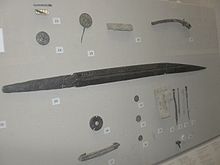Our website is made possible by displaying online advertisements to our visitors.
Please consider supporting us by disabling your ad blocker.
Seax of Beagnoth
51°29′03″N 0°08′38″W / 51.484202°N 0.143874°W
| Seax of Beagnoth | |
|---|---|
 The Seax of Beagnoth on display at the British Museum | |
| Material | Iron (inlaid with copper, brass and silver) |
| Size | Length: 72.1 cm (28.4 in) Width: 38.7 mm (1.52 in) Thickness: 8.2 mm (0.32 in) |
| Weight | 985 g (34.7 oz) |
| Writing | Runic, Old English |
| Created | 10th century |
| Period/culture | Late Anglo-Saxon |
| Discovered | 1857; River Thames, Battersea |
| Present location | Room 41, British Museum, London |
| Registration | 1857,0623.1 |
The Seax of Beagnoth (also known as the Thames scramasax) is a 10th-century Anglo-Saxon seax (single-edged knife). It was found in the inland estuary of the Thames in 1857, and is now at the British Museum in London. It is a prestige weapon, decorated with elaborate patterns of inlaid copper, brass and silver wire. On one side of the blade is the only known complete inscription of the twenty-eight letter Anglo-Saxon runic alphabet, as well as the name "Beagnoth" in runic letters. It is thought that the runic alphabet had a magical function, and that the name Beagnoth is that of either the owner of the weapon or the smith who forged it. Although many Anglo-Saxon and Viking swords and knives have inscriptions in the Latin alphabet on their blades, or have runic inscriptions on the hilt or scabbard, the Seax of Beagnoth is one of only a handful of finds with a runic inscription on its blade.
Previous Page Next Page


